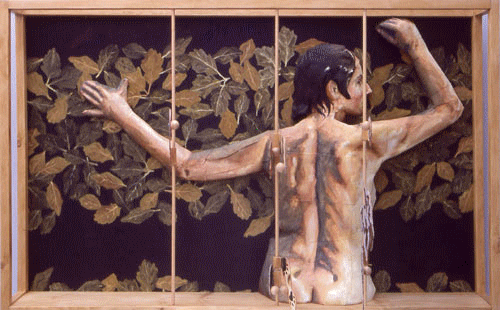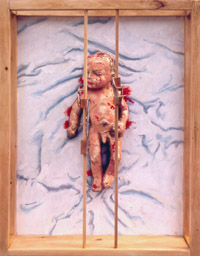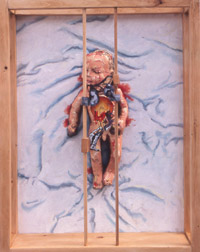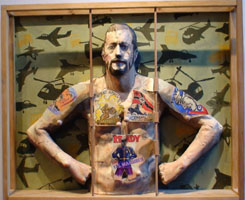Tattoo Paintings
| These tattoo
paintings have been developed to increase the range of narrative in my
art work and to expand the choices possible for the viewer.The tattoo
paintings involve a three-dimensional canvas figure derived from a life-cast
and small flat panels on wood that are suspended in front of the figure.
The flat panels are painted with the colors of skin upon which are added
tattoo images, with grisaille images on the inside of the panel.
The tattoos provide one layer of narrative; the grisaille images on the inside provide expansion to the narrative of the tattoos or, as in "Oh Grandmother what big teeth you have" a totally different narrative is introduced. These paintings give the viewer a large number of choices on the imagery and narrative of the paintings:
|
 |
|
 |
|
This was the first “Tattoo Painting” created. I sought a model with an interesting and defined back, which Jillian has. As this was the first, I used the familiar story of “Red Riding Hood” for the tattoos, and on the reverse another Grimm’s fairy tale, the “Seven Ravens”. Viewers have lots of choices before them: use Grimm’s narratives or combine imagery to create their own narrative cycle. |
|||||
Baby Jesus with Isenhiem Tattoos Oil on wood and canvas 22.5" x 28" x 8" 2005 To make the cast for this painting was naturally not done off a real baby but an anatomically correct newborn doll was used. This is Jesus just after his birth and viewers have a choice to make. Does the viewer move the tattoos out of view so there is just a baby or have the tattoos there as a burned in images of the ordained events to come. On the reverse of the tattoos, which are from the Isenheim altarpiece by Grunewald (1470-1528), are images of the events that came before using images from other artists.
|




